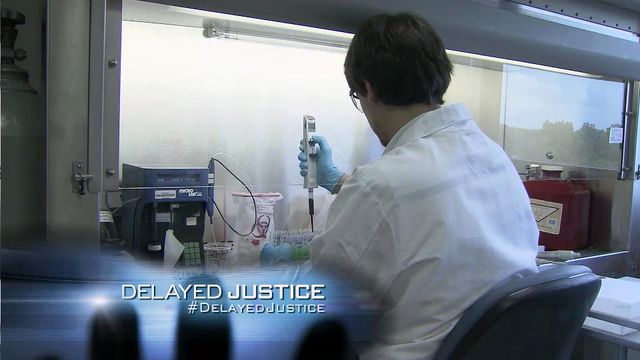Delayed Justice: Underfunded State Crime Lab could mean crisis for NC court system
In "Delayed Justice," WRAL examines the North Carolina State Crime Lab and out why financial resources and manpower are dreadfully behind the ever-growing case load.
Posted — UpdatedThe delay in getting DNA test results prompted prosecutors to drop a murder charge against Townsend. Now, he is back in jail, charged in the May 30 shooting death of Lewhahn Hood in Chapel Hill.
Although DNA results ultimately did not link Townsend to China's death, the case is an example of what law enforcement officials and those in North Carolina's criminal justice system say has been an ongoing source of frustration: The financial resources and manpower at the North Carolina State Crime Laboratory are dreadfully behind its ever-growing case load.
The backlog affects the accused – both guilty and innocent – who might sit in jail for years before their cases go to trial. Public safety is also at risk when those who do commit serious crimes are released back into society because evidence isn’t getting tested fast enough.
"Victims don't understand why the offender should be released or why the case should be dismissed because some resources aren't available to do the testing that should have been done much quicker," said Colon Willoughby who served as Wake County's district attorney for nearly 30 years before stepping down in March.
A 'deluge' of evidence
Part of the issue is what North Carolina Attorney General Roy Cooper calls a "deluge" of evidence that is overwhelming.
"You have 20,000 law enforcement officers across North Carolina sending tens of thousands of cases to the lab – many of them with multiple pieces of evidence – and you have about 124 scientist positions who are trying to handle all of this," he said. "The problem is that the cases keep coming and the scientists, who are working as hard as they can, can't keep up."
The State Crime Lab, which examines evidence in criminal investigations for more than 600 law enforcement agencies, averages 38,119 case submissions each year.
With 124 working scientists, that's an average of 307 cases per analyst.
The DNA section of the lab, alone, former Crime Lab Director Joseph John says, has 24 analysts to test the approximately 3,300 submissions a year. The North Carolina Department of Justice estimates it would take 55 analysts to test that DNA in a timely manner.
In the early 2000s, when retired SBI agent Bill Weis was the Crime Lab's assistant director, analysts were able to clear a backlog of DNA evidence in more than 6,000 unsolved rape cases, thanks to a boost in state funding.
The problem, Weis says, is that the DNA technology kept improving and the number of cases – not just rape, murder and other violent crimes but also property crimes – relying on DNA evidence kept increasing.
So did the North Carolina's DNA database, which ballooned from 18,000 profiles in 2001 to more than 270,000 this year.
"The more capability the lab has, the more evidence is going to come into the lab, which increases the backlog."
But laboratory resources aren't keeping up with the growth.
"Our court system is in crisis," John said. "The bottom line is we don't have enough scientists to meet the case load, and we're not paying our scientists a competitive rate to keep them employed here at the North Carolina State Crime Laboratory."
Low pay for analysts
Non-competitive pay and attrition are two more factors in the turnaround time for test results. Since 2010, 56 forensic scientists have left the Crime Lab, with half citing their reason as taking better-paying jobs elsewhere.
According to a 2013 independent study on salaries, the Crime Lab pays 16 percent below the average salary for the same occupation.
"If you don't have the people to do the work, if you don't pay them enough, you're going to have a significant delay in justice," Cooper said.
Many analysts are leaving to go to laboratories funded by local governments that want to avoid the State Crime Lab altogether for quicker results in certain types of testing.
"What you see sometimes is that these local positions pay significantly more than what the state pays," Cooper said.
That's why DNA analysts and funding for 10 percent salary increases have been at or near the top of the State Crime Lab's budget wishlist to the General Assembly for the past several years.
John Byrd, who took over as the Crime Lab's director in June, agrees that more people are needed to keep up with the growing case load.
"We have an obligation to the state and to the citizens to give them the highest quality that we could possibly give them in a timely manner," Byrd said. "And that is so frustrating not to be able to do that because of the lack of resources."
Expanding the State Crime Lab
Another desperate need, Byrd says, is more advanced crime laboratories in other parts of the state to help alleviate the case load in Raleigh.
There are satellite laboratories in Asheville and Greensboro, but they are limited in the type of testing that they can do. The Asheville lab, for example, doesn't perform toxicology tests, so it has to send those cases to Raleigh for testing.
Expansion of the western laboratory, Cooper says, would help speed up the testing process and take some of the burden off analysts in Raleigh.
Another reason for the crime lab expansion has to do with a 2009 U.S. Supreme Court ruling that requires analysts to testify at criminal trials. That means analysts in Raleigh have to travel across the state.
In the last fiscal year, Crime Lab analysts spent 2,800 hours – more than 70 weeks – in court and traveling to court.
"We need to look at modernizing our rules so that chemists can testify by way of video, so they don't have to drive from Raleigh to Nags Head to Manteo to testify in one particular case and drive all the way back," Willoughby said.
This issue is addressed in House Bill 1095, filed in May, which would allow forensic and chemical analysts to testify remotely through video technology.
The funding problem
All the problems appear to come down to not enough funding, which Cooper says he and others are urging state lawmakers to commit to in an effort keep the public safer.
"Since about 2008-2009, the lab has suffered significantly from lack of funding," he said. "It's very frustrating to see mayors, police chiefs, prosecutors, sheriffs, Mothers Against Drunk Driving demand additional help for the Crime Lab that doesn't come and, in fact, the crime lab ends up facing budget cuts."
Since 2007, the North Carolina Department of Justice has requested nearly $22 million for the Crime lab and 119 new positions. It received $5 million and 40 positions from approved budgets.
Positions not funded include 40 DNA analysts, which would mean the lab would be more than fully staffed today.
But criticism has plagued the lab in recent years – most notably in 2010 after Greg Taylor, a man serving life in prison for a murder he did not commit, was exonerated over questioned blood evidence.
That led to a wider independent review of other cases and ended in a scathing report that found the Crime Lab withheld certain test results in at least 190 cases.
Former State Supreme Court Chief Justice I. Beverly Lake called the discovery "a terrible indictment on the state of North Carolina."
Sen. Thom Goolsby, R-New Hanover, is co-chairman of the Joint Legislative Oversight Committee on Justice and Public Safety.
He says controversy like that can cause lawmakers to hesitate when determining how to prioritize spending, especially during a tight budget year.
"Whenever you have problems like that, you do have concerns on part of the legislature about where's the money going," Goolsby said.
He sees complicated logistical and organizational challenges at the lab.
"All the things that we can do – using private contractors to help with analysis – we've looked at all those things," Goolsby said. "We've got to continue to do that. I know the leadership is going to be changing, and they have got to continue to work with the legislature. The answer is not just money."
There is some potential relief on the way.
The proposed Senate budget includes $15 million for a new Western Regional Crime Laboratory in Edneyville, but it doesn't include money to hire new analysts or increase their pay rate by 10 percent.
The House budget also includes money for the Western lab expansion and funds to supply 10 new DNA analysts at a cost of $800,000. Funding for pay raises is also missing from the plan.
"Regrettably, it comes down to money," John said.
Crime Lab veteran Weis counters Goolsby's point, saying that there is a cost to keeping up.
"It's going to keep on coming back over and over if we don't focus on it," he said.
Weis remembers requesting more analysts years ago and was told by a lawmaker that he thought the legislature had already "fixed" the issue.
"It's not something that can be fixed in one day or one year or one bi-annual budget," Byrd said. "It's a long-term fix that we need their help with. And we're asking for their help."
• Credits
Copyright 2024 by Capitol Broadcasting Company. All rights reserved. This material may not be published, broadcast, rewritten or redistributed.






